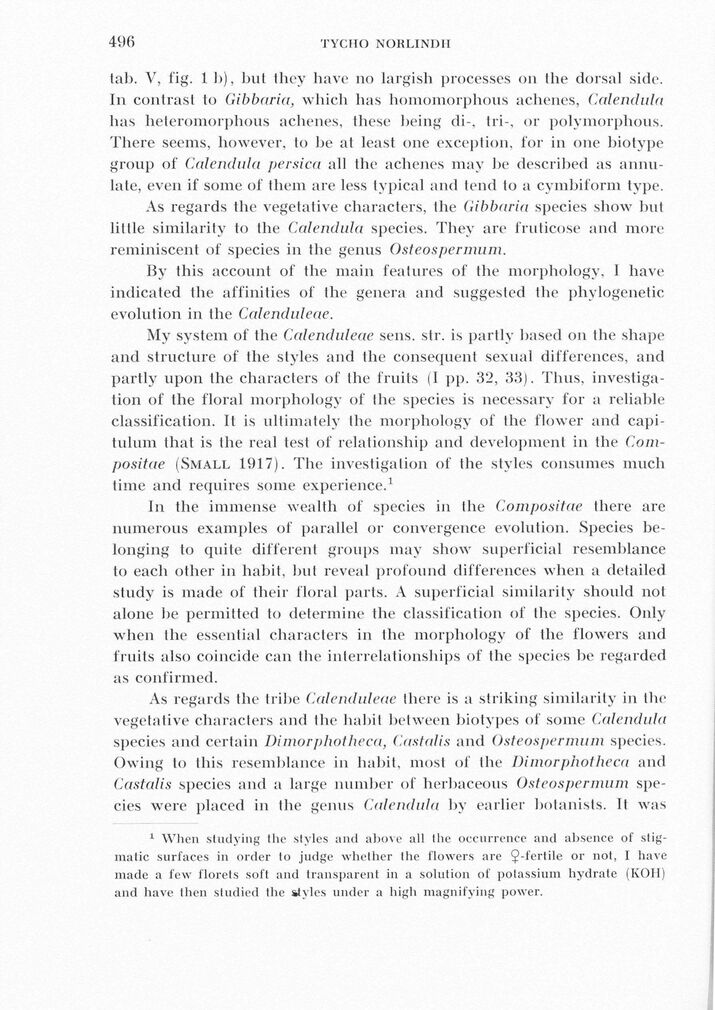
Full resolution (JPEG) - On this page / på denna sida - Sidor ...

<< prev. page << föreg. sida << >> nästa sida >> next page >>
Below is the raw OCR text
from the above scanned image.
Do you see an error? Proofread the page now!
Här nedan syns maskintolkade texten från faksimilbilden ovan.
Ser du något fel? Korrekturläs sidan nu!
This page has never been proofread. / Denna sida har aldrig korrekturlästs.
496
TYCHO NOR LINDH
tal). V, fig. 1 b), bill they have no largish processes ön the dorsal side.
In contrast to Gibbaria, which has homomorphous achenes, Calendula
bas heteromorphous achenes, these being di-, tri-, or polymorphous.
There seems, however, to be at least one exception, for in one biotype
group of Calendula persica all the achenes niay be described as
ännu-låte, even if some of them are less lypical and tend lo a cymbiform tvpe.
As regards the vegetative characters, Ihe Gibbaria species show hut
litlle similaritv to the Calendula species. They are fruticose and möre
reminiscent of species in Ihe genus Osteospermum.
By this account of the main features of the morphology, 1 have
indicated Ihe affinities of the genera and suggested the j)hvlogenetic
evolution in the Calenduleae.
My system of the Calenduleae sens. str. is partly based ön the shape
and structure of the slyles and the consequent sexual differences, and
partly upon Ihe characters of Ihe fruits fi pp. 32, 33). Thus,
investiga-tion of the floral morphology of Ihe species is necessary for a reliable
Classification. It is ultimately Ihe morphology of the flower and
capi-tulum that is the real test of relationship and development in Ihe
Com-positae (Small 1917). The investigalion of Ihe styles consumes much
time and requires some experience.1
In the immense wealth of species in Ihe Compositae |here are
numerous examples of parallel or convergence evolution. Species
be-longing to quite different groups may show superficial resemblance
to each other in habit, bul reveal profound differences when a detailed
study is made of their floral parts. A superficial similarity should not
alone be permitted to determine the Classification of the species. Only
when the essential characters in the morphology of the flowers and
fruits also coincide cail the interrelationships of Ihe species be regarded
as confirmed.
As regards the tribe Calenduleae there is a striking similarity in the
vegetative characters and the habit between biotypes of some Calendula
species and certain Dimorpliotheca, Castalis and Osteospermum species.
Owing lo this resemblance in habit, most of the Dimorphotheca and
Castalis species and a large number of herbaceous Osteospermum
species were placed in Ihe genus Calendula by earlier botanists. It was
1 When studying the slyles and above all Ihe occurrence and absence of
stig-matic surfaces in order lo judge whelher Ihe flowers are J-fertile or not, i have
made a few florets soft and transparent in a solution of polassium hydrate (koii)
and have Iben sludied the styles under a liigli magnifying power.
<< prev. page << föreg. sida << >> nästa sida >> next page >>